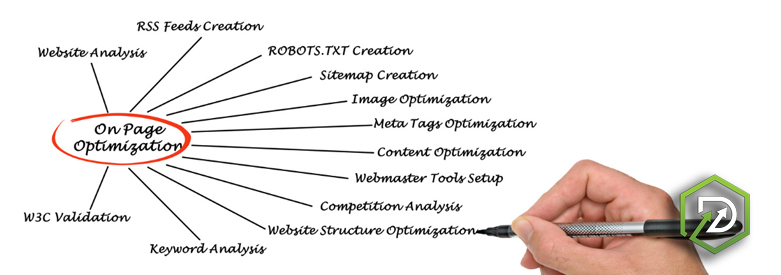SEO, DIGITAL MARKETING, LOCAL SEO
On-Page SEO Checklist for Website Ranking
In the fast-paced digital landscape, the success of a website largely depends on its visibility and ranking on search engines. To achieve a prominent online presence, it’s crucial to optimize your website through a well-structured on-page SEO strategy. In this comprehensive guide, we’ll walk you through an on-page SEO checklist that can significantly boost your website’s ranking.
Effective on-page SEO is the cornerstone of a successful digital marketing strategy. It involves optimizing various elements on your website to enhance its visibility and relevance to search engine algorithms. By following this checklist, you can achieve higher rankings, attract more organic traffic, and ultimately improve your website’s performance.
Keyword Research
Before diving into on-page optimization:
- Conduct thorough keyword research.
- Identify relevant keywords and phrases that your target audience is likely to use in search queries.
- Utilize tools like Google Keyword Planner or SEMrush to discover high-potential keywords.
Understanding Keyword Intent
It’s not just about finding keywords; it’s about understanding user intent behind those keywords. Are users looking for information, products, or services? Tailor your content to match their intent.
Long-Tail Keywords
Take notice of long-tail keywords. These are often less competitive and can drive highly targeted traffic. Incorporate them naturally into your content
DONE FOR YOU SEO - REQUEST A QUOTE
High-Quality Content
Content is king in the digital realm. Create informative, engaging, and valuable content that resonates with your audience.
Crafting Engaging Content
Write content that answers user queries and solves their problems. Engage your readers with compelling storytelling and actionable information.
Incorporating Multimedia
Enhance your content with images, videos, and infographics. Visual elements make your content more appealing and informative.
Meta Tags Optimization
Optimize your meta tags for better search engine visibility.
Title Tags
Craft compelling and descriptive title tags that include relevant keywords.
Meta Descriptions
Write enticing meta descriptions that encourage click-throughs. Keep them concise and informative.
Header Tags (H1, H2, H3, H4)
Structure your content with clear headings (H1 for the main title and H2, H3, H4 for subheadings). This improves readability and helps search engines understand your content hierarchy.
DONE FOR YOU SEO - REQUEST A QUOTE
URL Structure
Ensure your URLs are clean concise, and include relevant keywords. Avoid long, convoluted URLs.
Mobile-Friendly Design
With the increasing use of mobile devices, having a responsive design is imperative. Google rewards mobile-friendly websites with higher rankings.
Page Loading Speed
A fast-loading website not only improves user experience but also ranks higher in search results. Compress images and utilize browser caching to boost loading speed.
Image Optimization
Optimize images by reducing file sizes without compromising quality. Use descriptive alt tags for images to improve accessibility and SEO.
Internal Linking
Link to other relevant pages within your website. This helps search engines navigate your site and improves user experience.
External Linking
Include authoritative external links when relevant. It shows that you’ve done your research and adds credibility to your content.
Schema Markup
Implement schema markup to provide search engines with structured data about your content. This can enhance the visibility of rich snippets in search results.
User Experience (UX)
A user-friendly website with intuitive navigation keeps visitors engaged and encourages longer visits.
Social Signals
Engage with your audience on social media platforms. Social signals can indirectly impact your SEO rankings.
DONE FOR YOU SEO - REQUEST A QUOTE
Security (HTTPS)
Switch to HTTPS to ensure the security of your website. Google considers this as a ranking factor.
Analytics and Monitoring
Regularly monitor your website’s performance using tools like Google Analytics. Adjust your strategy based on data insights to improve your SEO efforts continuously.
Conclusion
By following this on-page SEO checklist, you’ll be well on your way to improving your website’s ranking and visibility in search engines. Remember that SEO is an ongoing process, so stay updated with industry trends and adapt your strategy accordingly.
FAQs
- What is on-page SEO? On-page SEO refers to the optimization of various elements on a website to improve its visibility and relevance in search engine results.
- Why is keyword research important for on-page SEO? Keyword research helps you identify the terms your target audience is searching for, allowing you to create content that aligns with their interests.
- How can I improve my website’s loading speed? You can enhance page loading speed by compressing images, leveraging browser caching, and using a content delivery network (CDN).
- What is schema markup, and how does it benefit SEO? Schema markup is structured data added to your website’s code to provide search engines with more context about your content. It can lead to rich snippets in search results, enhancing visibility.
- Why is mobile-friendliness crucial for SEO? Mobile-friendly websites rank higher in search results because they provide a better user experience for mobile users, who make up a significant portion of internet traffic.
With this comprehensive on-page SEO checklist, you have the tools to elevate your website’s ranking and drive organic traffic. Remember that SEO is an ongoing effort, so continuously refine your strategy to stay ahead in the digital landscape.
DONE FOR YOU SEO - REQUEST A QUOTE
